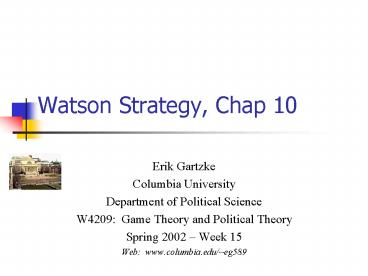Watson Strategy, Chap 10 - PowerPoint PPT Presentation
1 / 12
Title:
Watson Strategy, Chap 10
Description:
q1 = 450 q2/2 (Firm 1's best response function) ... In reality, firms select both price and quantity ... Firm that charges higher price sells no bricks (qi = 0) ... – PowerPoint PPT presentation
Number of Views:193
Avg rating:3.0/5.0
Title: Watson Strategy, Chap 10
1
Watson Strategy, Chap 10
- Erik Gartzke
- Columbia University
- Department of Political Science
- W4209 Game Theory and Political Theory
- Spring 2002 Week 15
- Web www.columbia.edu/eg589
2
Outline, Watson Chap 10
- Chap 10 Oligopoly, Tariffs, and Crime and
Punishment - Cournot Duopoly Model
- Bertrand Duopoly Model
- Tariff Setting by Two Countries
- A Model of Crime and Police
3
Chap 10 Oligopoly, Tariffs, and Crime and
Punishment
- Cournot Duopoly Model
- 2 Firms produce identical good (red brick)
- Simultaneously and independently select how many
bricks to produce (q1 for firm 1, q2 for 2) - Price depends on quantity (p 1000 q1 q2)
- Production cost 100/1000 bricks
- Firms select quantity S1 0, ?) and S2 0,?)
- Firms payoff is profit (price x quantity cost)
4
Cournot Duopoly Model
- Firm 1s payoff is
- u1(q1,q2) (1000 q1 q2)q1 100q1
- Firm 2s payoff is
- u2(q1,q2) (1000 q1 q2)q2 100q2
- Best response functions for Firms
- ?u1/?q1 1000 2q1 q2 100
- Setting this equal to zero and solving for q1, we
get - q1 450 q2/2 (Firm 1s best response
function) - Game is symmetric, so for Firm 2 BR2(q1) 450
q1/2
5
Cournot Duopoly Model
- Determine the quantities produced by each Firm
- BR1(q2) q1 450 (450 q1/2)/2
- q1 225 q1/4
- q1 300
- BR2(q1) q2 450 (450 q2/2)/2
- q2 225 q2/4
- q2 300
- Nash Eq. is inefficient
- Each firm better off producing at 225 (max
payoff) - Cannot credibly commit to this (PD-type problem)
6
Bertrand Duopoly Model
- Cournot model has firms selecting quantity
- In reality, firms select both price and quantity
- Demand implies definite relationship between p
and q - Think of firms selecting p or q, then market set
other - Makes sense to think of firms selecting quantity
- Butstrategic differences between p and q
- Additional insight from model where firms select
p - Two firms simultaneously, independently select p
- Industry demand p 1000 q1 q2
- Can be written as Q 1000 p where Q q1 q2
7
Bertrand Duopoly Model
- Facing p, consumers demand 1000 p 1000 units
brick - Specify the normal form of the game
- Firm that charges higher price sells no bricks
(qi 0) - Splits quantity if firms offer same price (1000
p)/2 - Firm is payoff if pi lt pj
- ui(p1,p2) (1000 pi)pi 100(1000 pi)
- (1000 pi)(pi 100)
- Firm is payoff if pi gt pj is 0
- Firm is payoff if pi pj
- ui(p1,p2) (1000 pi)pi /2 100(1000
pi)/2 - (1000 pi)(pi 100)/2
8
Bertrand Duopoly Model
- Neither firm can price below 100 in equilibrium
- If so, at least one firm earns negative profit
- Firms can guarantee profit of 0 by pricing at 100
- pi gt pj ? 100 cannot be the case
- If pi gt 100, firm j raises profit charging pi ?
pj gt 100 - pi pj gt 100 is not an equilibrium
- Firm i captures all of market by charging 100 ?
pi lt pj - Only possible equilibrium is pi pj 100
- Price equals marginal cost
- Equilibrium in Bertrand profit, Cournot profit
gt 0 - Price setting markets more competitive than
quantity setting
9
Tariff Setting by Two Countries
- Governments influence trade by imposing barriers
that restrict trade - Tariff tax on import of foreign commodities
- Large states can be better off with small tariff
- Assuming other states do not raise tariffs
- Example EU tariff on bananas
- Tariff creates wedge between international
price and domestic price for good - If wedge is large enough, tariff revenue may be
larger than welfare loss to own country from
tariff
10
Tariff Setting by Two Countries
- States are made worse off by uniformly high
tariffs - States benefit by finding way to enforce free
trade - Game
- Two countries (1 and 2)
- xi is tariff level of country i, for i 1,2 0 ?
xi ? 100 - Payoffs ui(xi,xj) 2000 60xi xixj xi2
90xj - ?ui /?xi 60 xj 2xi , 60 xj 2xi 0
- xi 30 xj /2
- Substituting, xi 30 (30 xi)/2 60
11
A Model of Crime and Police
- Optimal enforcement levels depend on
- How much it costs to catch and convict offenders
- The nature of punishments
- Response of offenders to changes in enforcement
- Game
- Two players criminal (C) and government (G)
- Gov. selects level of law enforcement x x ? 0
- Gov. payoff uG xc4 y2/x
- y2/x is negative effect of crime on society
- c4 is cost of law enforcement (positive constant)
12
A Model of Crime and Police
- Criminals payoff uC y1/2/(1 xy)
- y1/2 is value of criminal activity to criminal
(if not caught) - 1/(1 xy) is the probability that criminal
evades capture - Solution
- ?uG/?x c4 y2/x2
- c4 y2/x2 0, c4 y2/x2, x y/c2
- ?uC/?y (xy1/2)/(1 xy)2 1/(2y1/2(1 xy))
- (xy1/2)/(1 xy)2 1/(2y1/2(1 xy)) 0
- (xy1/2)/(1 xy)2 1/(2y1/2(1 xy)), y 1/x
- Substituting
- x (1/x)/c2, x 1/c, y c































